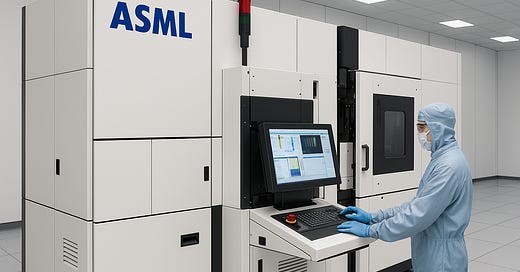ASML: Tariff Impacts and Current Valuation
In today’s article, we delve into the potential implications of tariffs on ASML’s fundamental business model and company valuation.
Dear Premium Subscribers,
Welcome back to the Quality Equities Premium Newsletter.
It was another wild week.
The US stock market was highly volatile but ultimately rallied this past week, with the S&P 500 gaining 5.7%, the Dow up 5%, and the Nasdaq jumping 7.3%. The sharp moves were driven by escalating and then easing trade tensions, as the White House first imposed sweeping tariffs (including a 125% duty on Chinese imports) only to partially reverse course midweek by pausing new tariffs for most countries. This policy shift spurred the S&P 500’s biggest one-day gain since 2008.
Despite the rebound, major indexes remain down for the year. Economic indicators added to the mixed picture, with consumer sentiment dropping to its second-lowest reading on record and gold hitting all-time highs as investors sought safety. The week highlighted how reactive markets remain to geopolitical uncertainty and trade policy signals.
If we take a closer look at the semiconductor sector specifically, the industry has been significantly impacted by recent US tariff policies, with companies like NVDA 0.00%↑ NVIDIA, ASML 0.00%↑ ASML, and KLAC 0.00%↑ KLA experiencing varied effects due to their unique positions in the global supply chain.
In today’s article, we delve into the potential implications of tariffs on ASML’s fundamental business model and company valuation.
Tariffs Impact
ASML, the leading supplier of photolithography equipment essential for advanced chip manufacturing, has experienced significant stock volatility recently, heavily influenced by new US tariffs and broader geopolitical tensions.
As of Friday, ASML's stock closed at $668.81, reflecting a recovery from earlier lows but, over the past year, the stock has declined by approximately 30% (and down roughly 40% from all-time highs). The stock has fluctuated between $550 and $700 over the past two weeks, with a notable decline following the most recent macroeconomic headlines.
The combination of reduced investments from key customers like Intel and Samsung, along with the imposition of US tariffs on European imports, meaningfully clouds the near-term outlook for ASML, though its long-term fundamentals remain solid.
Near-Term
ASML’s outlook has grown more complex in light of recent macroeconomic and geopolitical developments. Two major near-term challenges are weighing on sentiment: customer investment slowdowns and newly imposed US tariffs on European imports.
Key customers such as INTC 0.00%↑ Intel and Samsung have significantly cut or delayed capital expenditures, with Intel scaling back its 2025 spending by $10 billion and Samsung postponing deliveries of ASML’s EUV machines to its new Texas fab. These delays directly reduce ASML’s near-term order volume and revenue visibility, since these two customers have historically represented a substantial portion of ASML’s business. In response, ASML has revised its 2025 revenue guidance downward from an expected €40 billion to €30–€35 billion.
Compounding this is the US decision to impose tariffs on European-made semiconductor equipment, which includes ASML’s photolithography machines. These tariffs increase costs for US-based chipmakers like Intel and TSM 0.00%↑ TSMC, potentially delaying or scaling back their equipment purchases. The result could be a more cautious capex environment in the short term, further pressuring ASML’s growth trajectory.
While these developments pose headwinds, it’s important to note that ASML retains a critical advantage: it is the only company in the world capable of producing EUV lithography machines, which are essential for advanced chip manufacturing at leading-edge nodes (e.g., 3nm and below). This gives the company unparalleled pricing power and strategic importance, driving ASML’s ability to consistently grow net revenue per unit sold.
Long-Term
In the long run, the structural demand for ASML’s technology remains intact and even poised to grow, driven by rising complexity in chip design, continued AI and high-performance computing adoption, and re-shoring efforts in the US and Europe that require advanced fabrication tools.
While 2025 is now shaping up to be a “digestion year” with lower revenue growth and possible margin pressure, most analysts expect a rebound in 2026 and beyond as delayed projects resume and demand normalizes. In sum, ASML faces near-term turbulence but continues to be one of the most strategically positioned and technologically indispensable players in the global semiconductor ecosystem.
Valuation
Given the near-term and long-term impacts of tariffs, along with ASML’s strategic positioning and strong pricing power, the key question becomes: how should this influence our view of the company’s valuation?
Keep reading with a 7-day free trial
Subscribe to Quality Equities to keep reading this post and get 7 days of free access to the full post archives.






